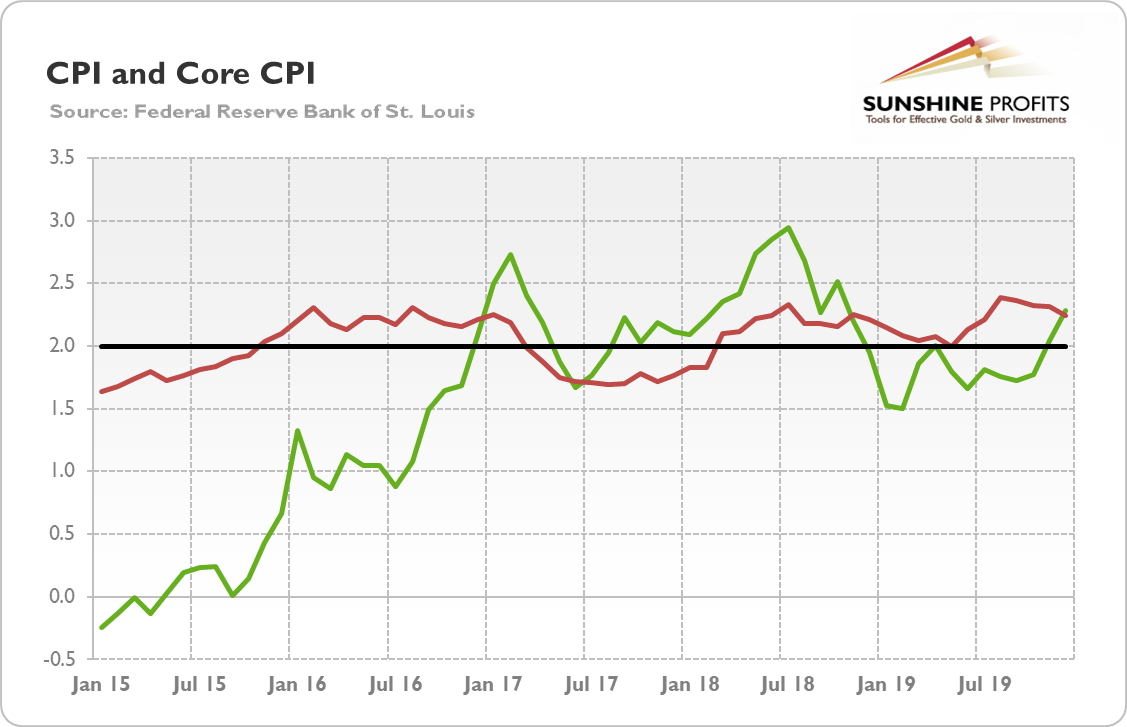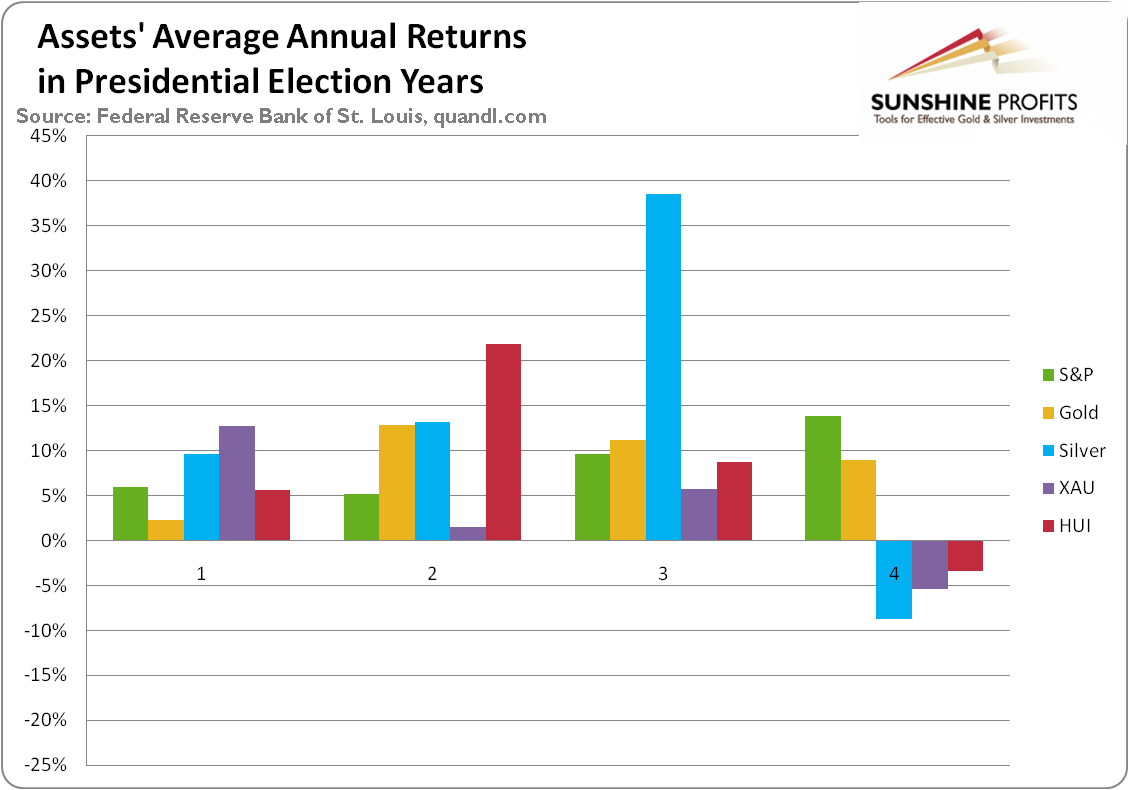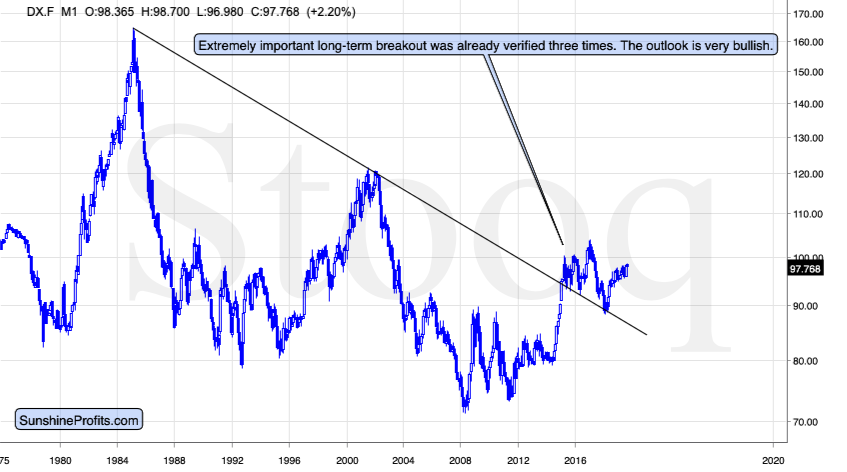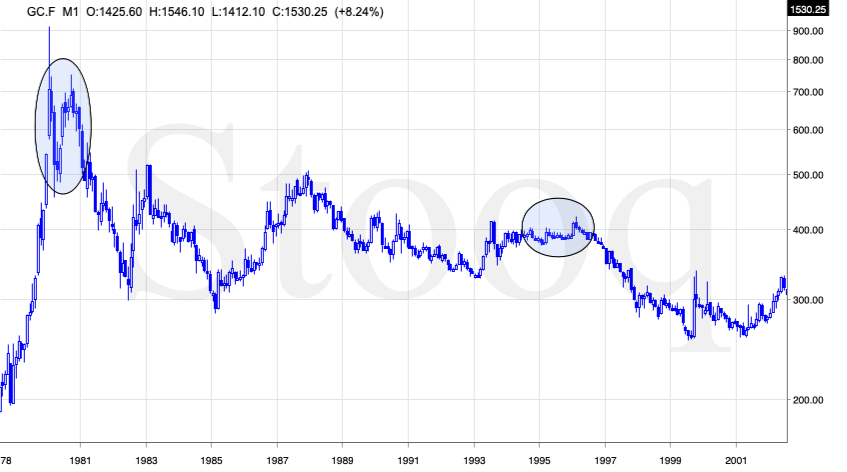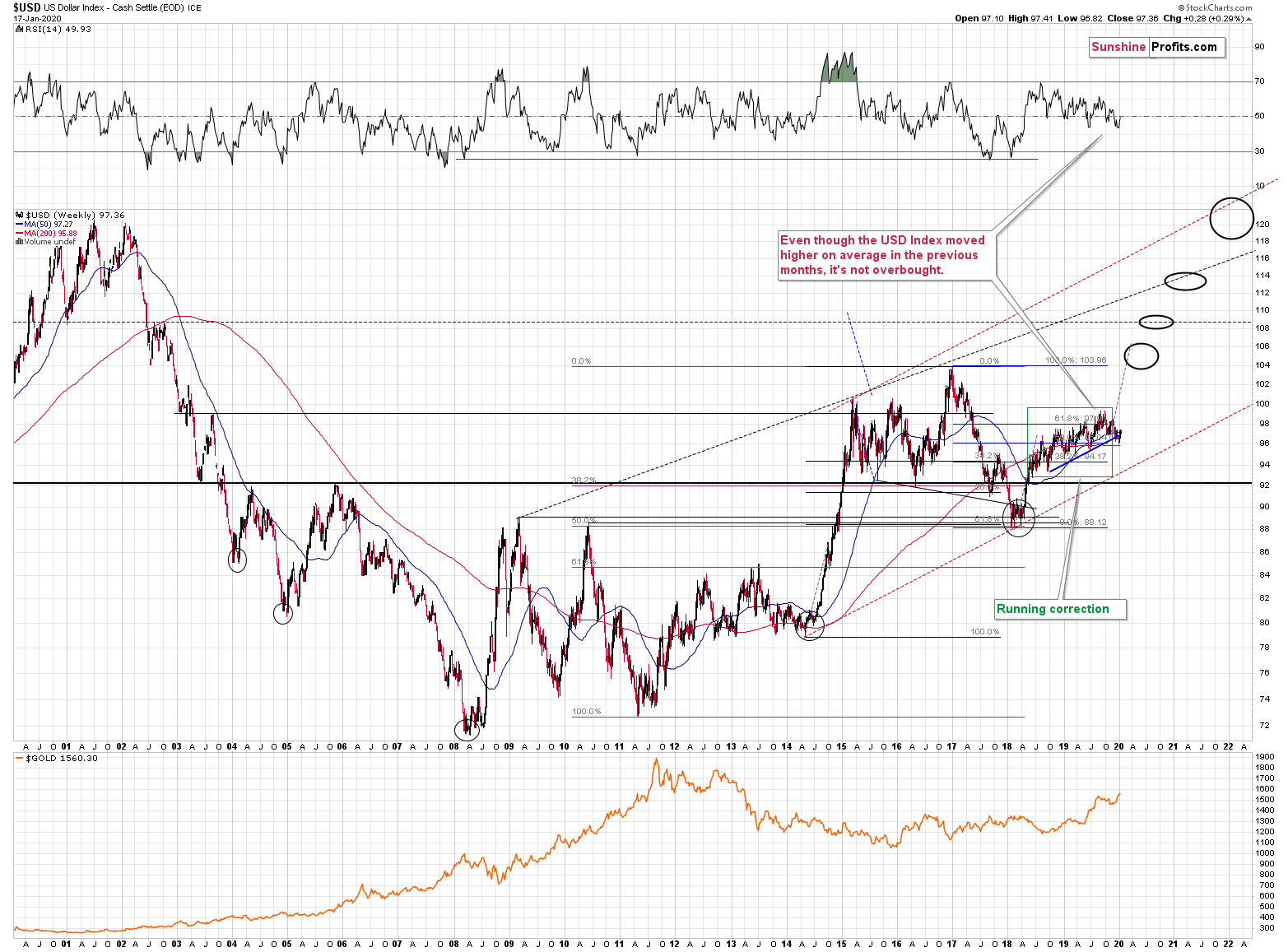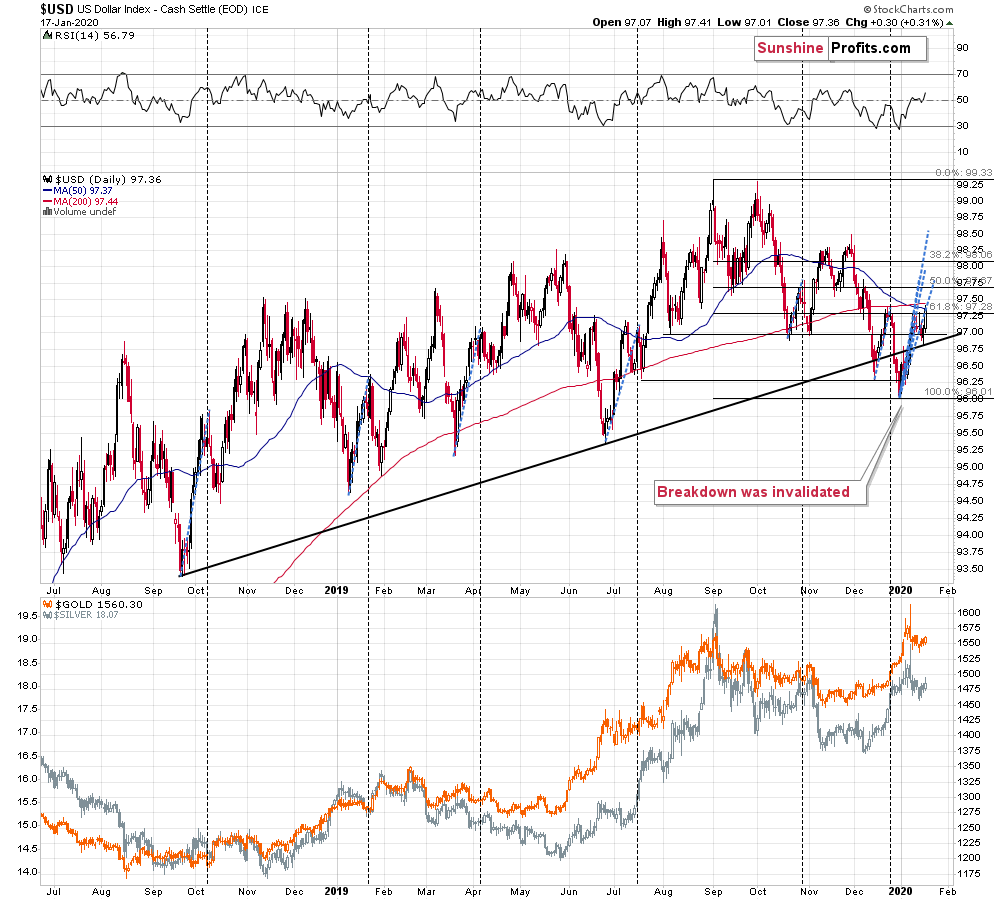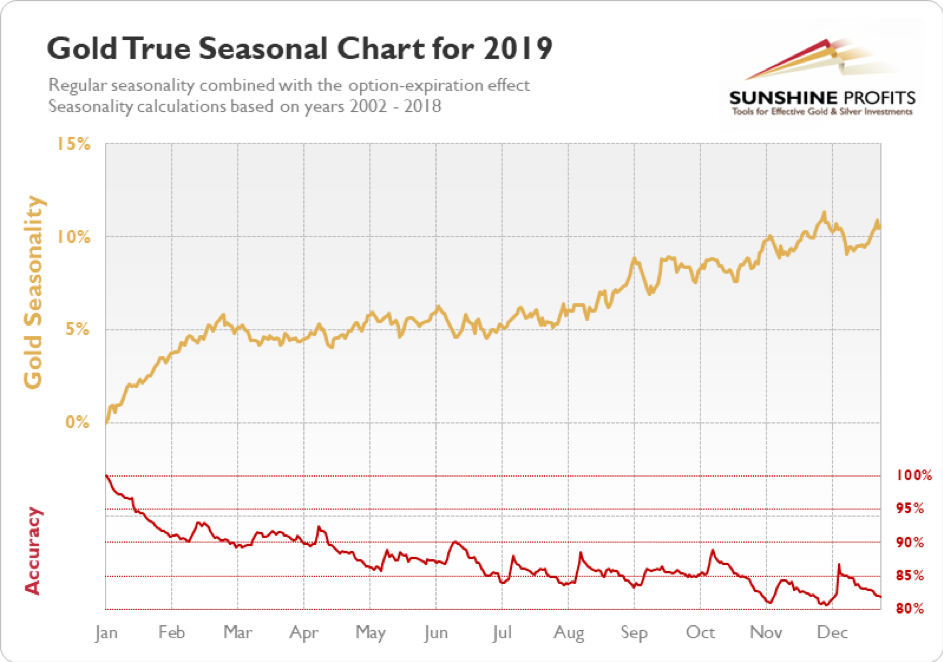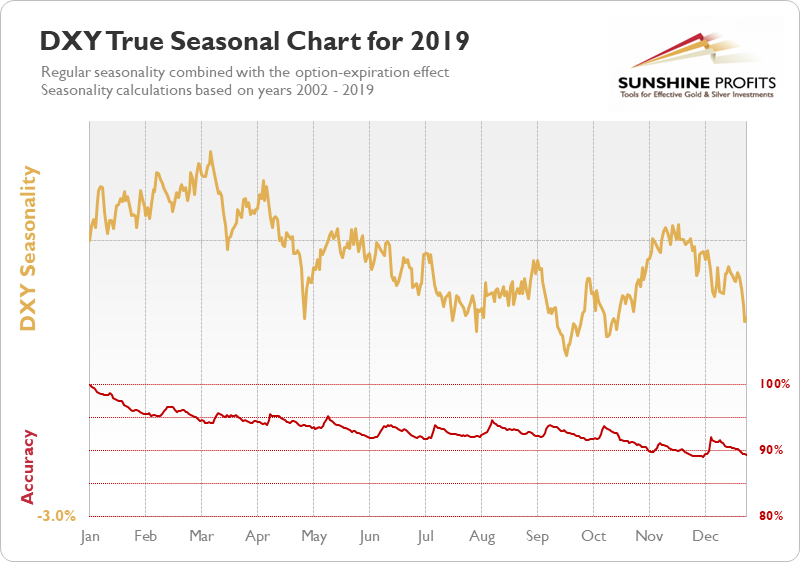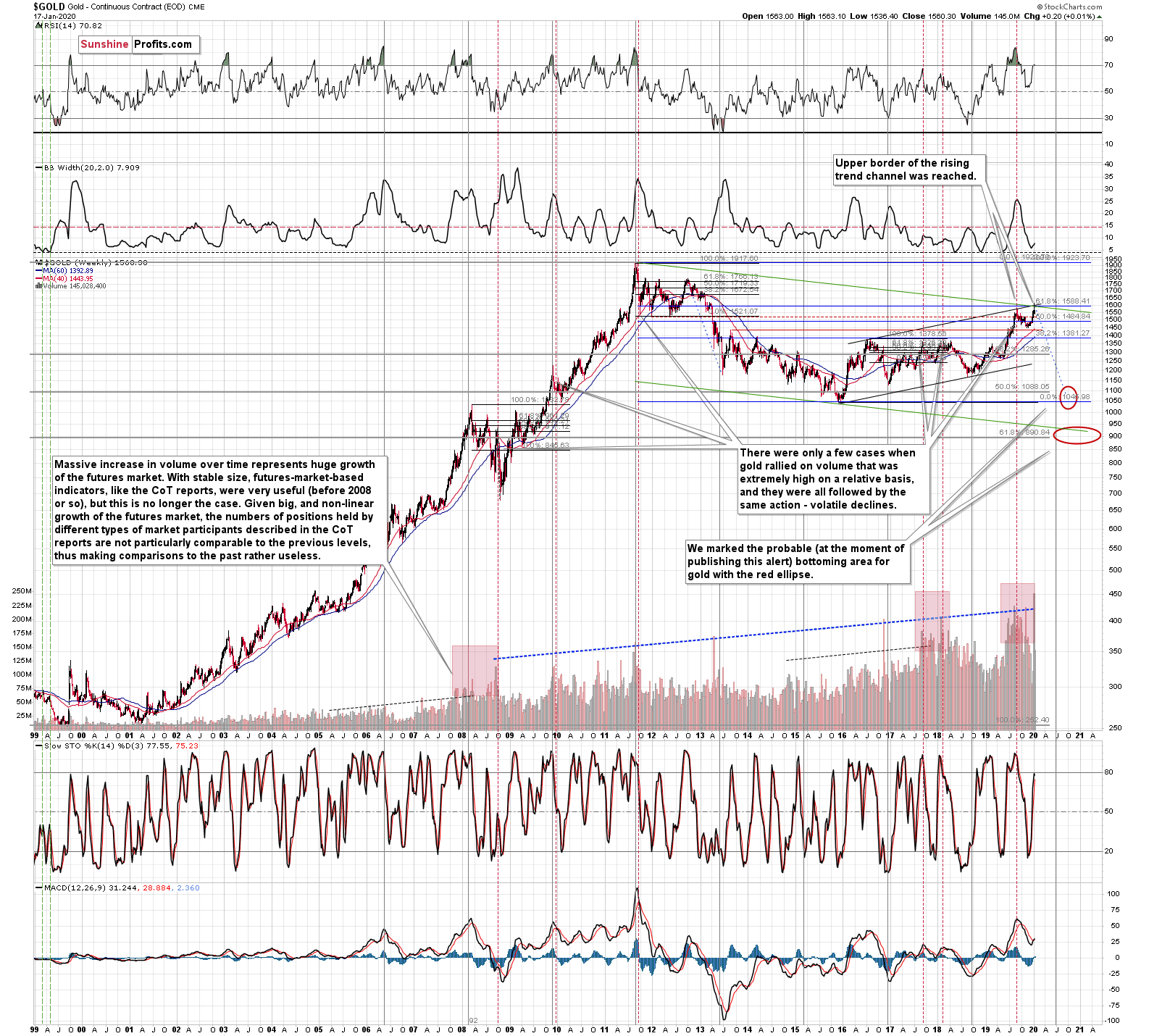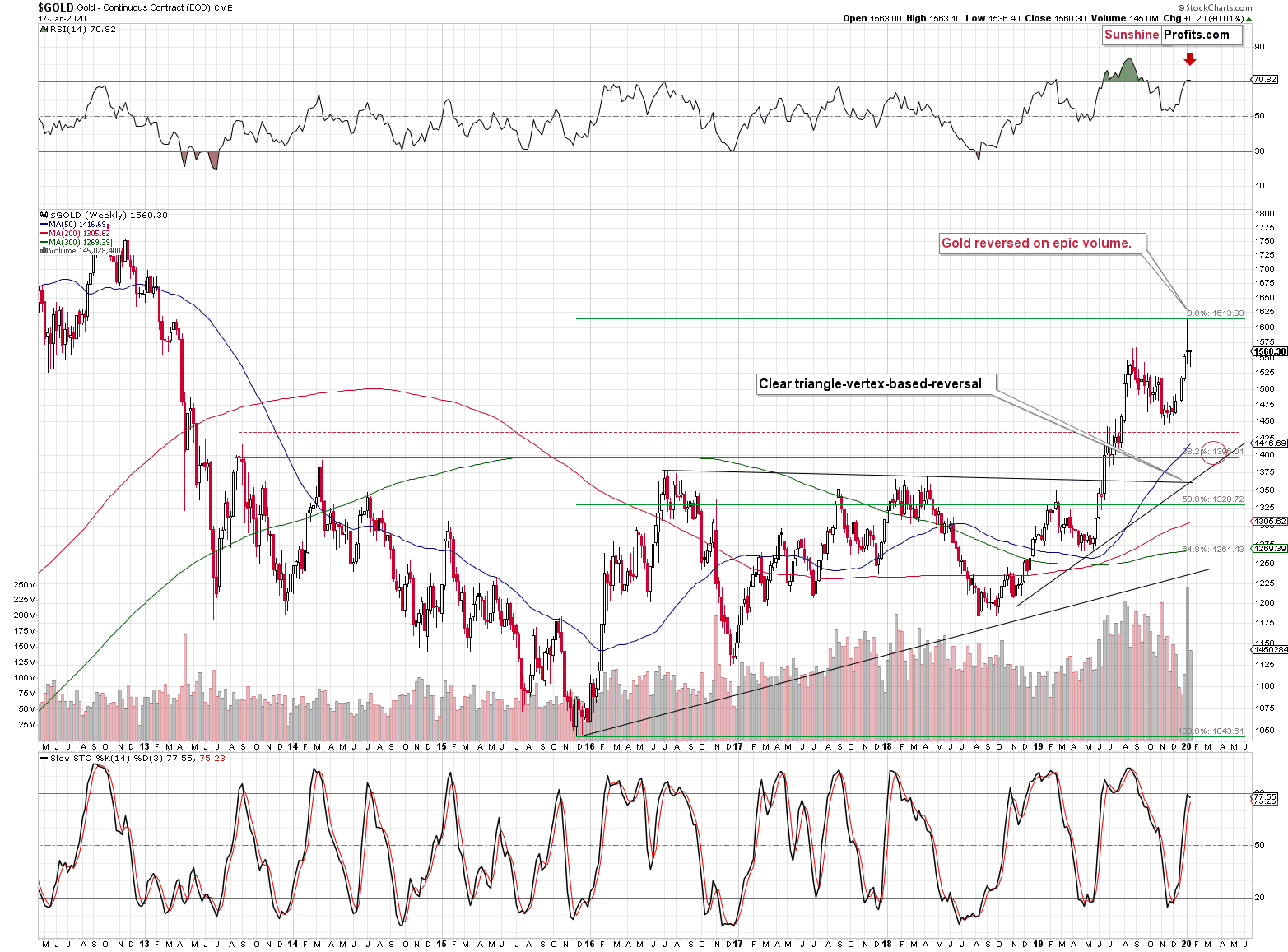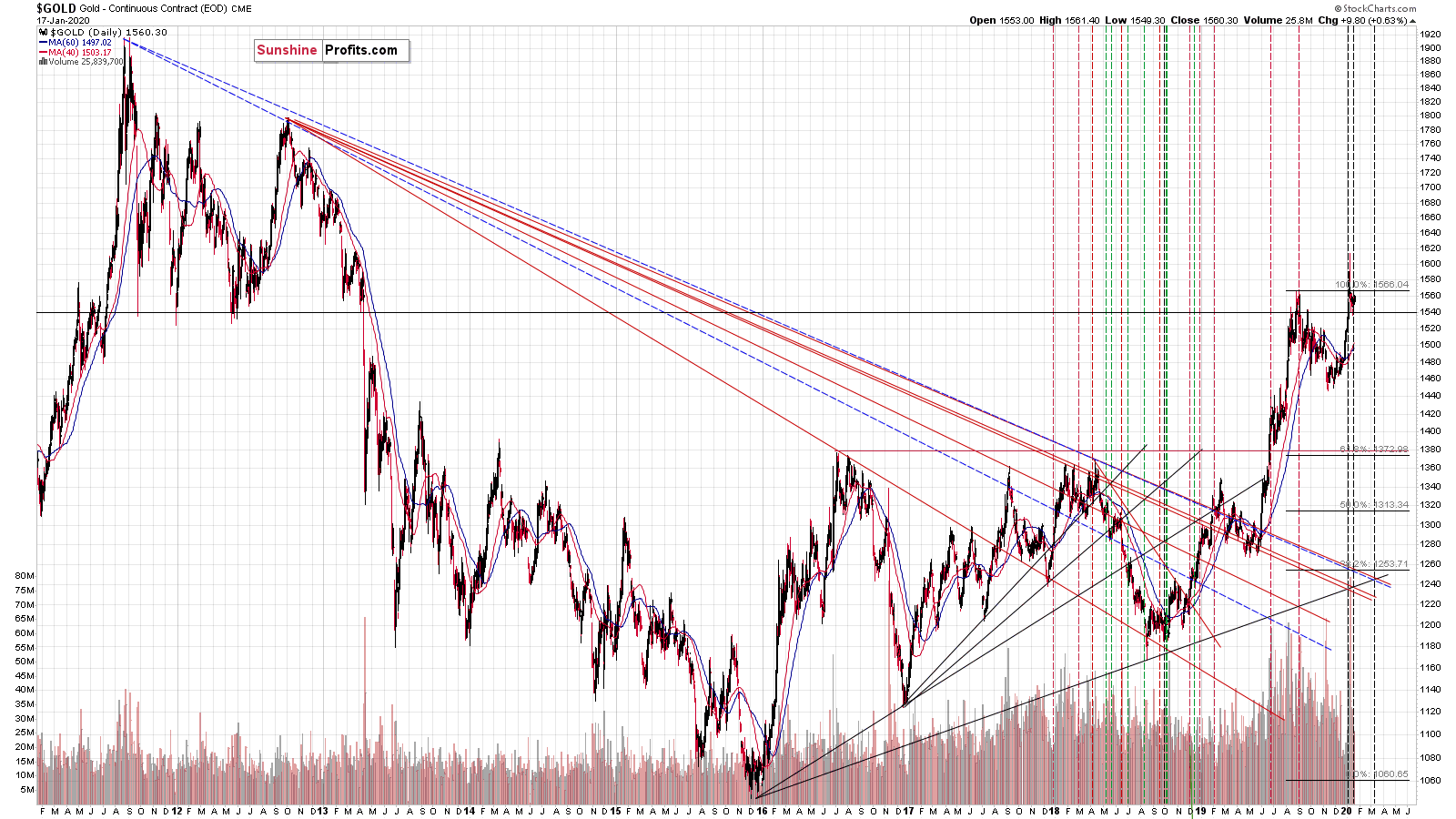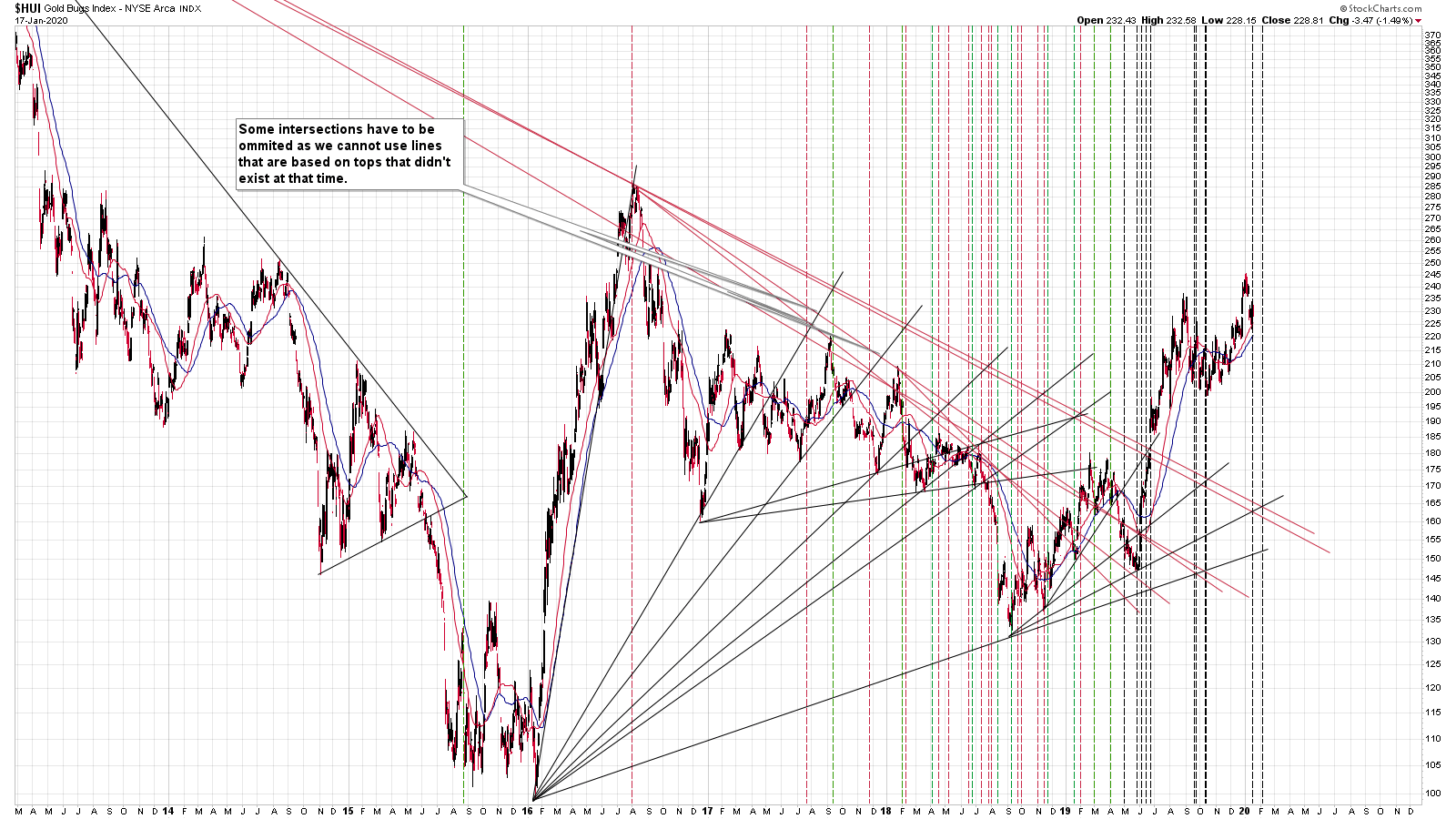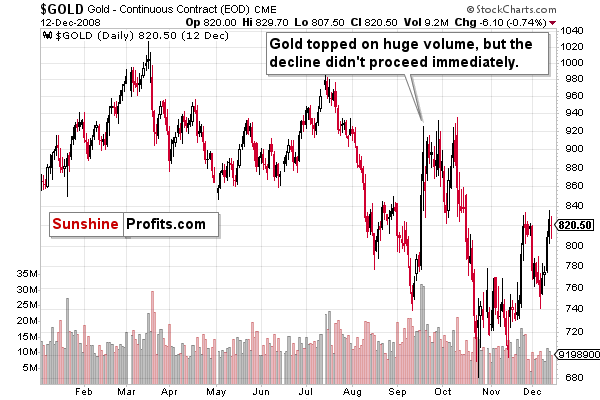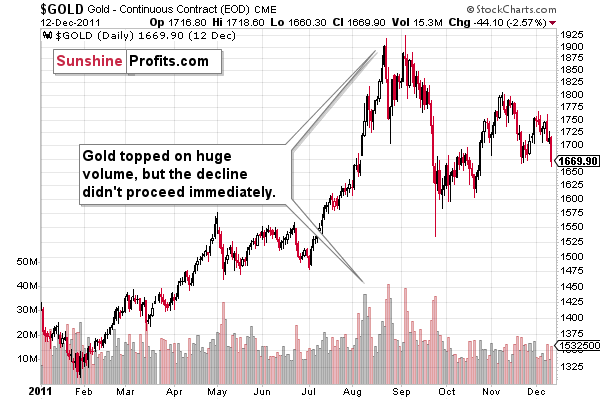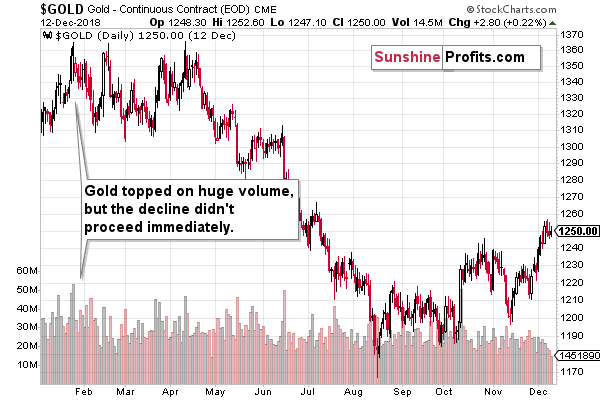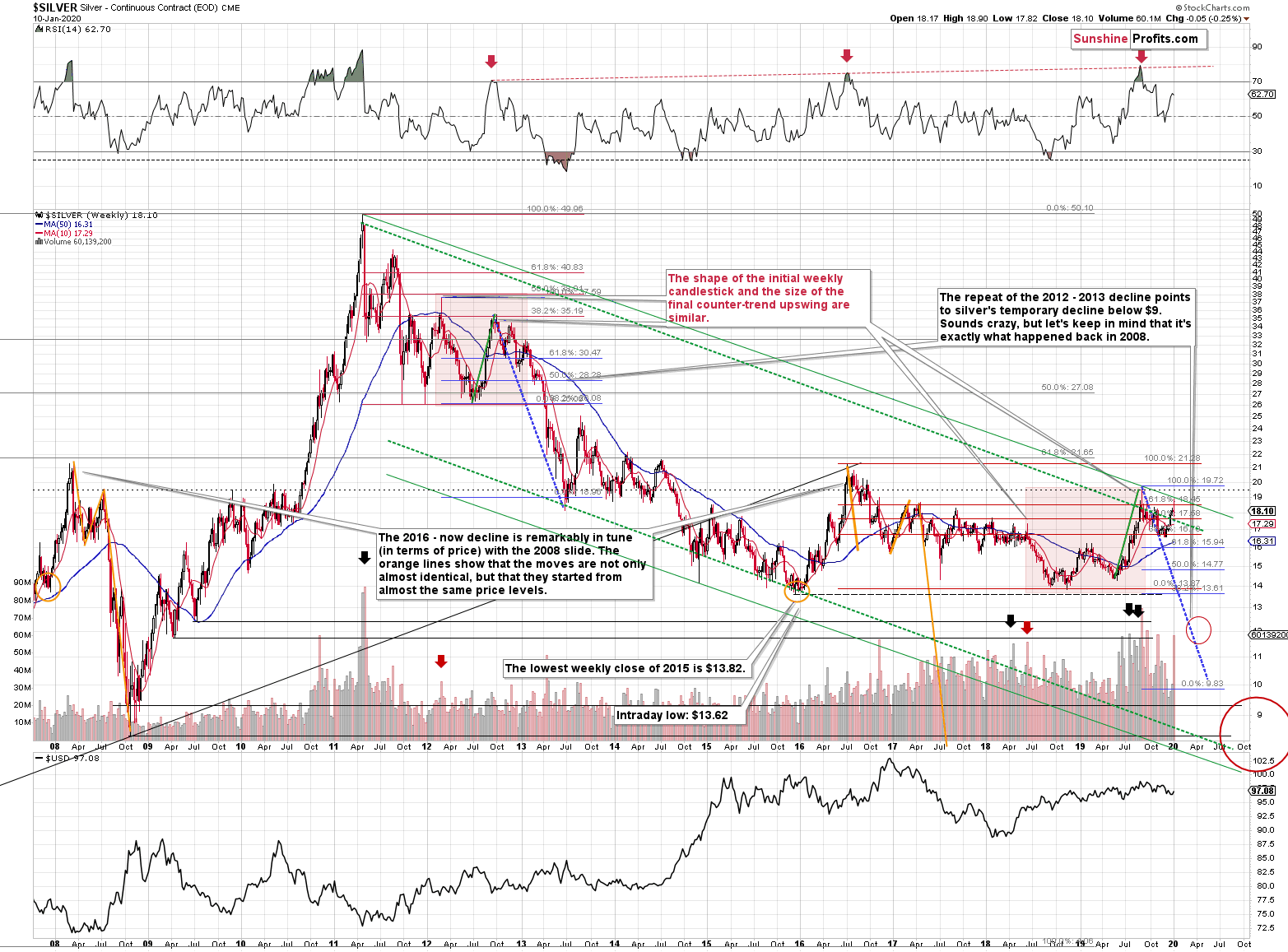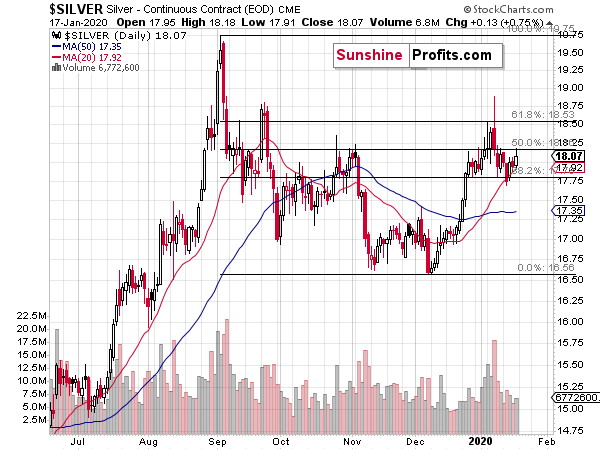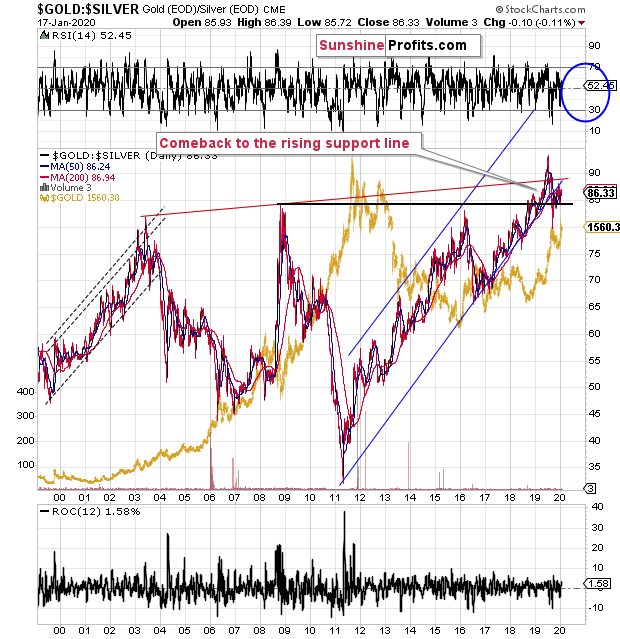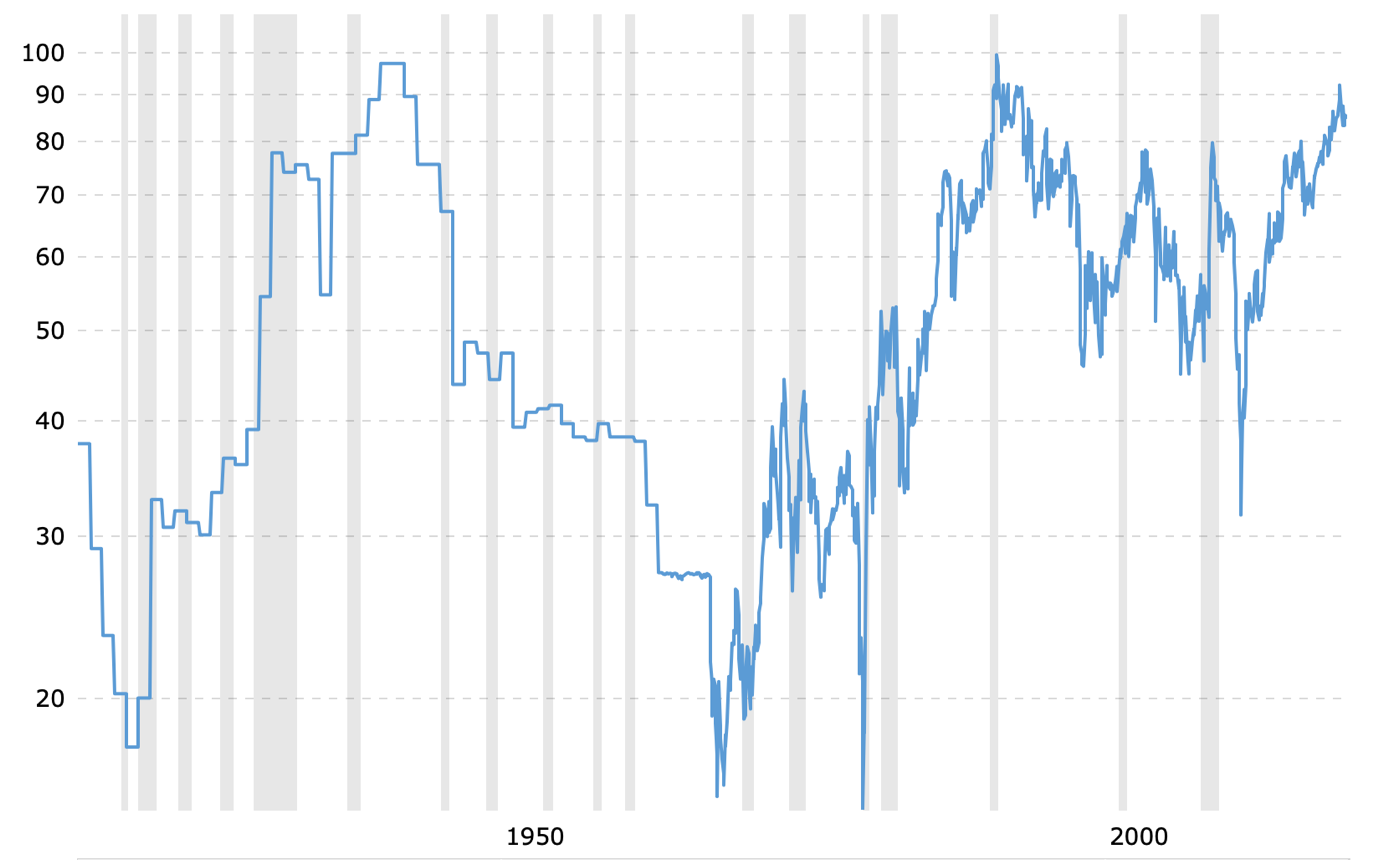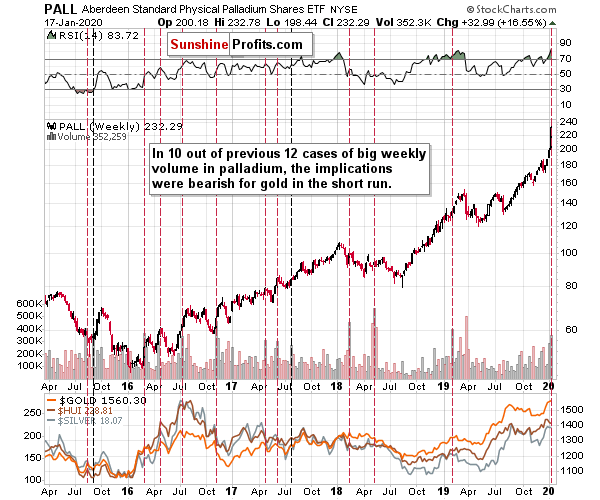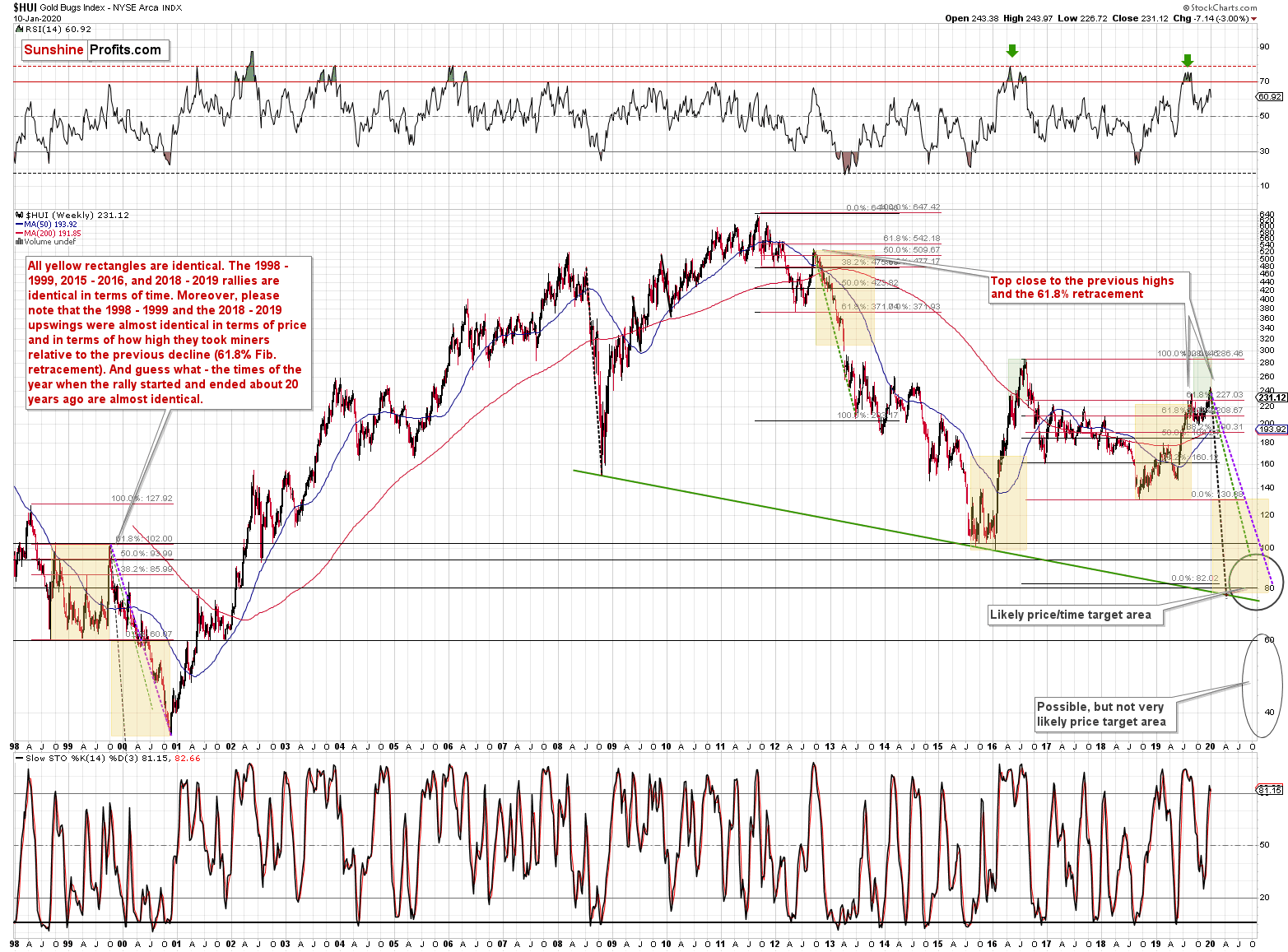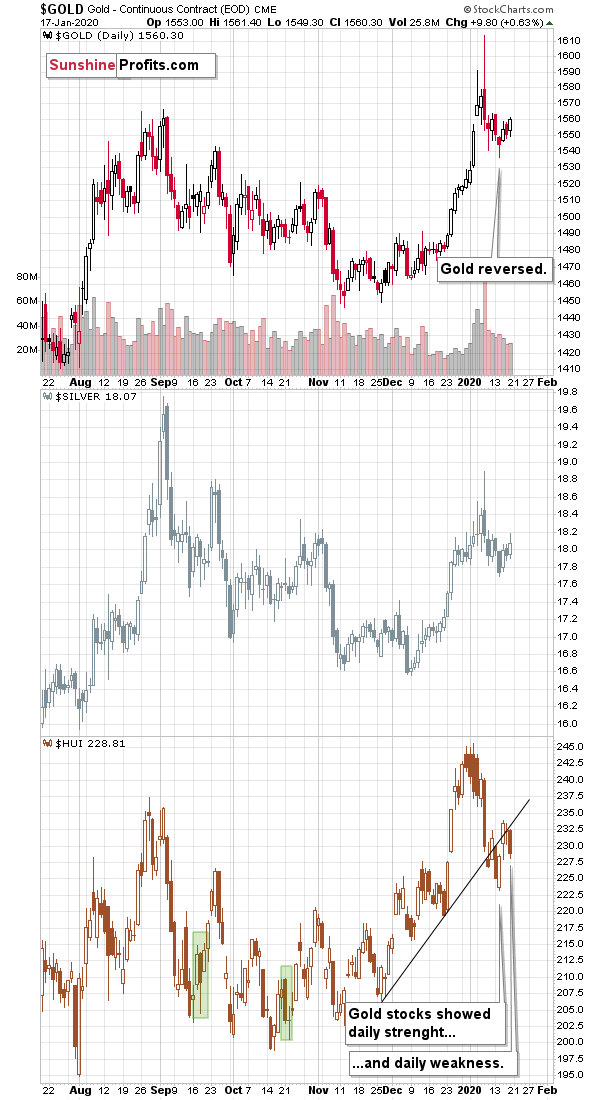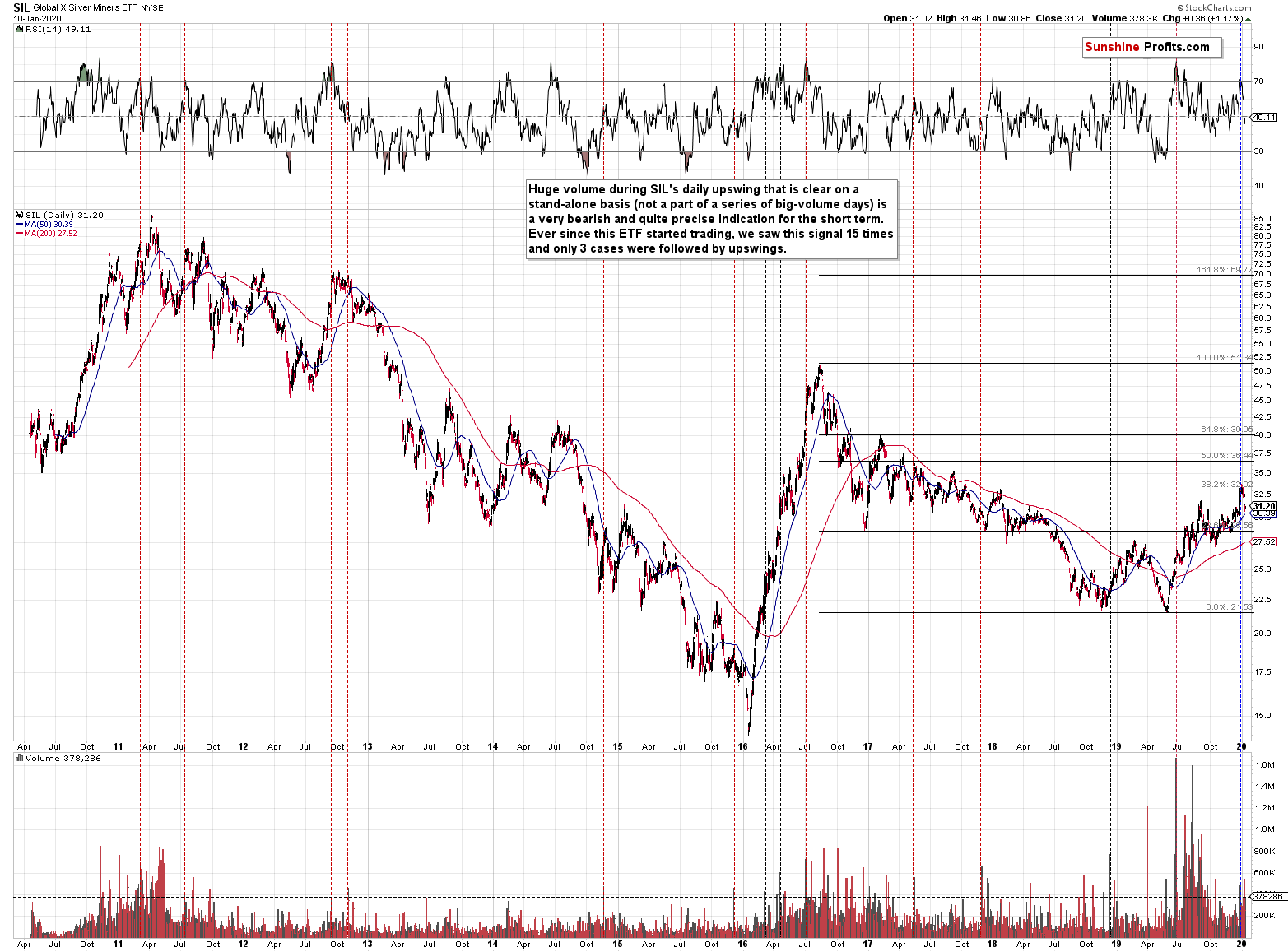Briefly: in our opinion, no speculative short position in gold, silver, and mining stocks is justified from the risk/reward point of view at the moment of publishing this Alert.
Welcome to this week's flagship Gold & Silver Trading Alert. As we promised you previously, in our flagship Alerts, we will be providing you with bigger, more complex analyses (approximately once per week) and it will usually take place on Monday. The U.S. markets are closed today due to the Martin Luther King day, and we generally don't post any Alerts on such days, but we thought that you might appreciate getting our analysis earlier, so we are posting it still today.
The most important analogies and long-term trends didn't change during the previous week and most of our previous extensive comments remain up-to-date. Of course, in today's analysis, we will update whatever needs to be updated or added. Two things that definitely deserve adding, are palladium's rally and gold's corrective upswing - is it over since the USD Index seems to have shaken off the decline. We'll cover these issues and many more.
Let's start with analyzing the recent U.S. economic reports as last week was full of them.
Last Week's U.S. Economic Reports
First, the CPI rose 0.2 percent in December, slightly below expectations and the 0.3-percent increase in November. But as the chart below shows, the CPI (and the core CPI as well) rose 2.3 percent over the whole 2019, which was the largest advance since the 3.0-percent rise in 2011. Yet inflation is still quite low by historical standards.
Chart 1: Annual percentage change in the US CPI (green line) and the core CPI (red line) from January 2015 to December 2019.
The wholesale inflation measured by the PPI rose just 1.3 percent last year, half as much as it did in 2018. It means that inflationary pressures are limited in the US economy. Moreover, the PCEPI, the Fed's preferred inflation gauge, rose just 1.5 percent over the twelve months ending in November. The muted inflation implies that it is unlikely that the Fed will hike the federal funds rate anytime soon. Although gold likes high and accelerating inflation, the U.S. central bank keeping interest rates on hold is positive for the gold prices.
Second, the Fed's Beige Book shows that the U.S. economic activity continued to expand "modestly" over the last six weeks of 2019. What is important is that the expectations of the near-term outlook "remained modestly favorable". However, the Beige Book reports also job cuts in manufacturing, transportation and energy sectors, which is in line with the last report on the nonfarm payrolls.
Third, when it comes to the industrial sector, industrial production fell 0.3 percent in December, the third decline in the past four months. In the whole last year, the output fell 1 percent. It shows that the sector is still weak, hurt by the trade wars, but excluding the motor vehicle sector, factory output rose 0.5 percent, so we could perhaps see revival in the near future.
Fourth, the retail sales increased 0.3 percent in December and 5.8 percent in the whole 2019, slightly above the average for the past 30 years. It shows that the consumer spending remains solid.
Last but not least, the privately-owned housing starts in December came at a seasonally adjusted annual rate of 1,608,000, which was 17 percent above November and 41 percent above the December 2018. The new residential construction reached a 13-year high, but it was mainly because of the warmer-than-usual temperatures. The change in building permits, which are less sensitive to weather, was weaker.
Reports' Implications for Gold
Leaving the industrial production aside, the last week's economic reports were generally positive, showing that the U.S. economy is still solid. It keeps looking like a goldilocks economy: inflation is low, the pace of economic growth is moderate, the retail sales and the housing market are solid. Theoretically, gold should suffer in face of positive economic news.
Indeed, as we have seen last week not only good economic reports, but also two important developments for the global economy. First, the potentially dangerous conflict between the US and Iran deescalated as quickly as it appeared. Second, the U.S. and China signed the 'phase one' accord in their trade dispute. In consequence, the U.S. stock market reached a new all-time record.
So, one could reasonably expect the bearish trend in the gold market. However, the yellow metal held steady, which is a solid performance given the headwinds that occurred last week. Why was gold was so resilient? One of the fundamental explanations might be that investors worry about the long-term consequences of the recent ultra-easy monetary policy. After all, even central bankers worry! Dallas Fed President Robert Kaplan said last week that the recent Fed's actions were contributing to elevated risk asset valuations as they have given investors a green light to buy risky assets and this is a concern. Anyway, gold's resilience in face of headwinds might be a bullish sign. It might also be a part of a regular business-as-usual cycle that takes place after gold tops on huge volume, and that's something we'll discuss in the following part of this analysis.
Before moving to technical price charts, we would like to remind you that this year is the final year of the U.S. Presidential cycle and that's the weakest year for silver and mining stocks. This doesn't change anything regarding the short-term price moves, but it is something that will likely have an impact throughout the year.
Assets' Returns and Presidential Cycle
Average annual return of S&P (1948-2015, green line), gold (London P.M. Fix, 1972-2015, yellow line), silver (London Fix, 1972-2015, blue line), XAU Index (1984-2015, purple line) and HUI Index (1997-2015, red line) in presidential election cycles.
Gold's performance is more or less average in the election year, but in case of silver and mining stocks we see something very different. Namely, the election year is the only year when - on average - they all decline.
So, does it mean that gold won't be affected by this specific cyclicality, but silver and miners will be? Not really. It seems that the above chart shows that silver and miners - on average - lead gold lower. They perform worst in the election year and the yellow metal is the worst choice in the following year - the first year of presidency.
Silver and miners have already been performing very poorly relative to gold if we look at the long-term charts. Did silver or miners exceed their 2016 highs? They are not even close, especially silver. So, it seems that the pattern that we should be seeing at this time of the U.S. Presidential cycle, is already here and it started a bit earlier.
This means two things: even more weakness in silver and miners that we saw, and gold catching up with the decline.
The fundamental background is one thing, but the technical details are another. They provide details and insights that are impossible to get by just analyzing the news. Let's see how much the recent strength in gold changed the technical picture, and what's going on in the most important - long-term - charts featuring gold and the related markets.
The most important point that remains intact (and unaffected by what happened in the past week) is that the USD Index is after a massive breakout that was already verified more than once. The connection with the gold market remains intact as well.
The Big Picture View of the USD Index
(please click on the charts to enlarge them)
The 2014-2015 rally caused the USD Index to break above the declining very-long-term resistance line, which was verified as support three times. This is a textbook example of a breakout and we can't stress enough how important it is.
The most notable verification was the final one that we saw in 2018. Since the 2018 bottom, the USD Index is moving higher and the consolidation that it's been in for about a year now is just a pause after the very initial part of the likely massive rally that's coming.
If even the Fed and the U.S. President can't make the USD Index decline for long, just imagine how powerful the bulls really are here. The rally is likely to be huge and the short-term (here: several-month long) consolidation may already be over.
There are two cases on the above chart when the USD Index was just starting its massive rallies: in the early 1980s and in mid-90s. What happened in gold at that time?
Gold Performance When the USD Index Soars
These were the starting points of gold's most important declines of the past decades. The second example is much more in tune with the current situation as that's when gold was after years of prolonged consolidation. The early 1980s better compare to what happened after the 2011 top.
Please note that just as what we saw earlier this year, gold initially showed some strength - in February 1996 - by rallying a bit above the previous highs. The USD Index bottomed in April 1995, so there was almost a yearly delay in gold's reaction. But in the end, the USD - gold relationship worked as expected anyway.
The USD's most recent long-term bottom formed in February 2018 and gold seems to have topped right now. This time, it's a bit more than a year of delay, but it's unreasonable to expect just one situation to be repeated to the letter given different economic and geopolitical environments. The situations are not likely to be identical, but they are likely to be similar - and they indeed are.
What happened after the February 1995 top? Gold declined and kept on declining until reaching the final bottom. Only after this bottom was reached, a new powerful bull market started.
Please note that the pace at which gold declined initially after the top - in the first few months - was nothing to call home about. However, after the initial few months, gold's decline visibly accelerated.
Let's compare the sizes of the rallies in the USDX and declines in gold. In the early 80s, the USDX has almost doubled in value, while gold's value was divided by the factor of 3. In the mid-90s, the USDX rallied by about 50% from its lows, while gold's value was divided by almost 1.7. Gold magnified what happened in the USD Index in both cases, if we take into account the starting and ending points of the price moves.
However, one can't forget that the price moves in USD and in gold started at different times - especially in the mid-90s! The USDX bottomed sooner, which means that when gold was topping, the USDX was already after a part of its rally. Consequently, when gold actually declined, it declined based on only part of the slide in the USDX.
So, in order to estimate the real leverage, it would be more appropriate to calculate it in the following way:
- Gold's weekly close at the first week of February 1996: $417.70
- USDX's weekly close at the first week of February 1996: 86.97
- Gold's weekly close at the third week of July 1999: $254.50
- USDX's weekly close at the third week of July 1999: 103.88
The USD Index gained 19.44%
Gold lost 39.07% (which means that it would need to gain 64.13% to get back to the $417.70).
Depending on how one looks at it, gold actually multiplied USD's moves 2-3 times during the mid-90 decline.
And in the early 1980s?
- Gold's weekly close at the third week of January 1980: $845
- USDX's weekly close at the third week of January 1980: 85.45
- Gold's weekly close at the third week of June 1982: $308.50
- USDX's weekly close at the third week of June 1982: 119.01
The USD Index gained 39.27%
Gold lost 63.49% (which means that it would need to gain 173.91% to get back to $845).
Depending on how one looks at it, gold actually multiplied USD's moves by 1.6 - 4.4 times during the early-80 decline.
This means that just because one is not using U.S. dollars as their primary currency, it doesn't result in being safe from gold's declines that are accompanied by USD's big upswings.
In other words, the USD Index is likely to soar, but - during its decline - gold is likely to drop even more than the USD is going to rally, thus falling in terms of many currencies, not just the U.S. dollar.
Please note that there were wars, conflicts and tensions between 1980 and 2000. And the key rule still applied. Huge rallies in the USD Index mean huge declines in gold. If not immediately, then eventually.
Having covered the most important factor for the USD Index and gold, let's take a look at the other - also important - factors influencing both of these markets.
More on the USD Index and Gold
The USD Index is moving up in a rising trend channel (all medium-term highs are higher than the preceding ones) that formed after the index ended a very sharp rally. This means that the price movement within the rising trend channel is actually a running correction, which is the most bullish type of correction out there. If a market declines a lot after rallying, it means that the bears are strong. If it declines a little, it means that bears are only moderately strong. If the price moves sideways instead of declining, it means that the bears are weak. And the USD Index didn't even manage to move sideways. The bears are so weak, and the bulls are so strong that the only thing that the USD Index managed to do despite Fed's very dovish turn and Trump's calls for lower USD, is to still rally, but at a slower pace.
The temporary breakdown below the rising blue support line was invalidated. That's a technical sign that a medium-term bottom is already in.
Now, as far as the short-term outlook for the USD Index is concerned, the situation is unclear. We previously wrote that it was about "time" for the USD Index to correct based on the lengths of the previous post-bottom rallies. Before taking its first breather, the USDX used to rally for about 2 weeks and applying the same to the recent bottom implied some sort of pullback.
What makes the situation unclear is the fact that we already saw "some sort of pullback". It was not as big as the previous pullbacks, but it was definitely present. So, at this time it's not clear if the bigger pullback is still just around the corner, or if it had already taken place.
Of course, there's more to the precious metals market than just the USD Index, and the PMs did move higher as we had indicated based on their own signals - short-term strength in the miners and gold's daily reversal.
What can we tell about the following days in the PMs based on what the USDX is doing? If the USD Index does correct, the PMs are likely to rally once again for a few days. If the USD Index continues to rally, the PMs are likely to decline, but not necessarily right away. After all, gold was able to hold up relatively well despite USD's comeback to the mid-December high.
This means that even if the USDX's pullback is already over, we are still likely a day or a few days away from the PMs short-term outlook becoming very bearish. This means that waiting on the sidelines for a few extra days is likely a good idea. Depending on what the USDX does and how gold reacts to it, we'll most likely get either confirmations that the local top in the PMs is already in (but without a major decline initially) or that several days of higher prices are still ahead.
Having said that, let's take a look at the current seasonality in gold. In short, it's positive at its face value, and it's neutral once one considers the likelihood of USD Index's upswing.
As a reminder, our True Seasonal gold charts are an improved version of the regular seasonality, as they additionally estimate also the Accuracy and they are based not only on the plain seasonality, but also on the way gold price tends to move around the options expiration dates (they don't take place at exactly the same day each month, so the regular seasonality ignores this effect).
The option expiration effect is not huge in case of the yellow metal; it's more significant in case of silver. Also, this effect is not very visible in case of yearly charts, such as the one that we present below, but it becomes more useful in case of the quarterly charts that we also feature from time to time (and which you can access on your own over here). You can read more details about this effect in this report (note: the pdf file is quite heavy, so it may take a while to load).
Gold Seasonality Lessons
At the beginning of the year, gold tends to rally while the USD's performance varies in January (while the USDX soars in early February).
This year gold corrected after moving higher, but so far the month is still up. If the USD Index rallies sharply at the beginning of February, gold would likely react with a decline unless it proves that it's able to withstand USD's impact like it did last week.
Last week's move higher in gold despite the lack of big decline in the USDX is bullish for the very short term, but it doesn't tell us much with regard to the next few weeks. Whatever bullish action is likely to happen in gold, could simply happen before the end of January, and then gold could once again react to USD's strength in a regular way - by declining.
Retracements, Reversals and Gold
Naturally, there are many other things that need to be taken into account while analyzing the market other than just the USD Index and gold's seasonality. For instance, the analogy in terms of the previous long-term retracements within big declines. In particular, the declines that we saw in 2008 and between 2011 and 2015.
The markets have fractal nature, meaning that the price patterns that we see in one timeframe, can also apply on a different scale, with proportionate implications. For instance, silver's tendency to outperform gold at the end of a bigger move higher - it takes place on a small scale in case of local rallies, and it's more visible in case of more medium-term moves.
In case of gold's long-term chart, the Fibonacci retracements are the thing that likely applies on a different scale right now. In today's second fundamental point, we explained why certain patterns repeat themselves despite taking place at entirely different times and under different circumstances. The Fibonacci retracements are one of the patterns that keeps on emerging in many markets, including gold. The 61.8% Fibonacci retracement is the most classic one.
In both previous cases (the 2011-2015 and 2008 declines), gold declined initially after the top (March 17, 2008, September 6, 2011) and then corrected a bit more than 61.8% of the decline before forming the final short-term top (July 15, 2008, October 5, 2012) from which the biggest declines started. The 2016 decline was also preceded by a sharp rally and it was also characterized by a temporary move back up - slightly above the 61.8% Fibonacci retracement - before the main part of the slide.
Now gold also moved to the 61.8% Fibonacci retracement level (precisely, it tried to move above it and managed to do so only very temporarily), but to one of much bigger meaning.
The 61.8% Fibonacci retracement that's based on the entire 2011 - 2015 decline is $1,588. That was the initial high in gold. It was the high that gold failed to break above.
Many people - especially those selling gold - will want to tell you that gold has been in a huge rally since late 2015. In reality, however, gold remains in a corrective mode after declining from 2011. And if you don't want to trust gold's classic retracement tool, maybe you'll trust silver or gold stocks.
Silver is mere $4 above its 2015 bottom. That's about $32 below the 2011 high. Big rally in the precious metals sector? What big rally? It's only gold that's been showing significant strength and taking a closer look reveals that it just corrected (!) 61.8% of the previous decline. It's relatively common for markets to retrace this amount before the previous trend resumes.
And gold miners? The HUI Index is about 400 index points below its 2011 high and only about 130 index points above the 2016 low.
That's a correction, not a new powerful rally. We will see one, but this is not the real deal just yet.
And speaking of major gold moves, please note how perfectly the long-term triangle-vertex-based reversals in gold worked.
Gold was very likely to reverse, and it did exactly that, just like we had written earlier.
Reversals should be confirmed by big volume and last week's volume was truly epic, which is a perfect bearish confirmation. It was the biggest weekly gold volume EVER.
We already wrote a lot today about gold and we will write even more, also about silver and miners. We will cover multiple signs that point to lower precious metals prices in the following weeks and months (not days, though). But, the record-breaking-volume reversal is alone enough to make the outlook bearish. That's how significant this reversal-volume combination is.
In addition to the above, the above chart shows the next medium-term target for gold - at about $1,400 level. This target is based on the mid-2013 high in weekly closing prices, the 38.2% Fibonacci retracement based on the 2015 - 2019 upswing, and the rising medium-term support line. Of course, that's just the initial target, gold is likely to decline more after pausing close to $1,400.
Since the triangle-vertex-based reversal technique worked so well recently, let's check what else it can tell us. The below charts feature the reversal points based on the very long-term triangles.
Gold seems to have reversed (a short-term bottom) close to its reversal date and the next one is at the beginning of March.
In case of gold stocks, we also saw a short-term bottom at the reversal date and the next one is due early February.
Please note that the lack of the reversal points doesn't mean that there will be no reversals - this technique is neutral in this case.
The implications are that the beginning of February and the beginning of March are likely to include some kind of reversal. If gold moves higher from here and the USD Index corrects lower, the PMs would be likely to top in the first days of February.
Before moving to silver, we would like to bring your attention to the key technical development of this year - the record-breaking volume in gold. In particular, we would like to tell you what gold did after it topped on extreme volume in the previous cases. The three very similar cases volume-wise and volatility-wise are the September 2008 top, the 2011 top, and the early 2018 top. How did gold perform immediately after the tops?
In all three cases, gold topped on huge volume, but the decline didn't proceed immediately. There was a delay in all cases and a re-test of the previous high. The delay took between several days and a few months.
Since a similar pattern followed the huge-volume tops, it seems that we might see a re-test of the recent high in the near future. Don't get us wrong - the true rally has most likely ended, but we might see a move close to the January high, a move to it, or even a move that gets gold very insignificantly above it. That's when people bought gold at the top in 2008, 2011, and 2018, and we don't want you to fall for this market trick. Knowing what happened then - huge declines in the price of gold - should prevent you from buying on hope for a breakout to new highs. Oh, and by huge declines, we mean the ones where gold declined by hundreds of dollars.
Based on the triangle-vertex-based reversals, it seems that we won't have to wait as long as a few months, but a rally until the end of the month is quite possible.
Let's take a look at gold's sister metal - silver. There are no upcoming long-term reversals for silver based on the triangle-vertex technique for silver, but there are other issues that its worth to keep in mind.
Silver Shares Its Two Cents
The key analogy in silver (in addition to the situation being similar to mid-90s) continues to be the one between 2008 and the 2016 - now periods.
There is no meaningful link in case of time, or shape of the price moves, but if we consider the starting and ending points of the price moves that we saw in both cases, the link becomes obvious and very important. And as we explained in the opening part of today's analysis, price patterns tend to repeat themselves to a considerable extent. Sometimes directly, and sometimes proportionately.
The rallies that led to the 2008 and 2016 tops started at about $14 and we marked them both with orange ellipses. Then both rallies ended at about $21. Then they both declined to about $16. Then they both rallied by about $3. The 2008 top was a bit higher as it started from a bit higher level. And it was from these tops (the mid-2008 top and the early 2017 top) that silver started its final decline.
In 2008, silver kept on declining until it moved below $9. Right now, silver's medium-term downtrend is still underway. If it's not clear that silver remains in a downtrend, please note that the bottoms that are analogous to bottoms that gold recently reached, are the ones from late 2011 - at about $27. Silver topped close to $20.
The white metal hasn't completed the decline below $9 yet, and at the same time it didn't move above $19 - $21, which would invalidate the analogy. This means that the decline below $10, perhaps even below $9 is still underway.
Naturally, the implications for the following months are bearish.
Let's consider one more similarity in the case of silver. The 2012 and the 2018 - today performance are relatively similar, and we marked them with red rectangles. They both started with a clear reversal and a steady decline. Then silver bottomed in a multi-bottom fashion, and rallied. This time, silver moved above its initial high, but the size of the rally that took it to the local top (green line) was practically identical as the one that we saw in the second half of 2012.
The decline that silver started in late 2012 was the biggest decline in many years, but in its early part it was not clear that it's a decline at all. Similarly to what we see now, silver moved back and forth with lower highs and lower lows, but people were quite optimistic overall, especially that they had previously seen silver at much higher prices (at about $50 and at about $20, respectively).
The 2012 corrective upswings were actually the final chances to exit long positions and enter short ones. It wasn't easy to do it back then just as it's not easy to do so right now. But the size of the decline that followed speaks for itself. In investing and trading, what's pleasant and what's profitable is rarely the same thing.
Silver's recent huge reversal confirms gold's reversal. Silver's volume didn't set a new record, but it was huge nonetheless. Definitely more than enough to make silver's reversal important and reliable. It's very bearish on its own and extremely bearish when examined together with gold's reversal.
On a short-term basis, we see that silver tried to move above the 61.8% Fibonacci retracement based on the most recent decline and at the same time, it moved just a little above the 61.8% Fibonacci retracement that you can see on the previous long-term chart. Taking the 2016 top as the starting point and the 2018 low as the ending point, we get $18.45 as the retracement. Silver had moved less than 10 cents above it and then it invalidated this tiny breakout. Then it invalidated the more short-term breakout as well (the one that you see on the above chart).
The odds are that silver's December - January upswing is already over.
Meanwhile, silver's relationship with gold continues to support medium-term downtrend in the precious metals sector.
In early July 2019, the gold to silver ratio topped after breaking above the previous highs and now it's after the verification of this breakout. Despite the sharp pullback, the ratio moved back below the 2008 high only very briefly. It stabilized above the 2008 high shortly thereafter and now it's moving slowly up once again. Well, slowly if you take the day-to-day price movement into account. In case of the long-term point of view, the strong uptrend simply resumed after a quick breather.
Anything after a breakout is vulnerable to a quick correction to the previously broken levels. On the other hand, anything after a breakout that was already confirmed, is ready to move higher and the risk of another corrective decline is much lower.
The most important thing about the gold and silver ratio chart to keep in mind is that it's after a breakout above the 2008 high and this breakout was already verified. This means that the ratio is likely to rally further. It's not likely to decline based on being "high" relative to its historical average. That's not how breakouts work.
Besides, the true, long-term resistance in the gold to silver ratio is at about 100 level. This level was not yet reached, which means that as long as the trend remains intact (and it does remain intact), the 100 level will continue to be the likely target.
Before moving to mining stocks, let's take a look at the little metal (the market is really tiny) that made many headlines recently - palladium.
Palladium Examination
Palladium soared recently and last week's volume was exceptional. While the price move itself might or might not indicate anything special for the major parts of the precious metals market: gold, silver, and mining stocks, the volume reading does.
In 10 out of 12 previous cases when palladium rallied on a weekly basis and it happened on big volume, the implications were bearish for gold in the short run (not necessarily in the immediate term).
Given the pace at which palladium has been moving higher, RSI well above 70 and the big volume, the current situation is similar to what we saw in early 2019. Gold, silver, and mining stocks declined after the huge-volume week in palladium. After the daily volume spike in palladium, gold moved higher on the next day and then it started a short-term decline.
The implications here are bearish for the next week or two, but they are rather neutral for today and tomorrow.
Having said that, let's take a look at the situation in the mining stocks, starting with miners' flagship analogy.
Turning to Gold Miners
In case of gold stocks, we see that the history is repeating with an almost exact 20-year delay. This might sound crazy... Until you see the chart revealing how precise it is, and how well it fits to what happened now and in 2012 as well.
(as a reminder, clicking on the chart will expand it)
Let's start with something relatively more familiar - the Fibonacci retracements. Back in 2012, the HUI Index retraced almost 61.8% of the preceding rally before the decline continued. That was one of the reasons that we thought that the 2019 rally won't get much above this retracement, if at all. Indeed, the August breakout above this retracement was very short-lived. The current move higher took the HUI just a little above the August high and this move was already invalidated as gold miners declined this year.
The important thing is that this is not the only time when this retracement stopped a sizable, yet counter-trend rally before a big decline.
The 1999 top formed almost exactly at the 61.8% Fibonacci retracement. That's one similarity between what happened recently and in 2012.
The second similarity is what's so exciting about this discovery. The length of the rally. All yellow rectangles on the above chart are identical. The 1998 - 1999, 2015 - 2016, and 2018 - 2019 rallies are identical in terms of time. Most importantly, the 1998 - 1999 and the 2018 - August 2019 upswings were almost identical in terms of both: time and price. And that's in addition to both rallies ending at the same Fibonacci retracement.
Let's re-state it again. Both rallies took practically the same amount of time, and the rallies were almost alike in terms of size - percentagewise.
The current move up is just a little above the August high and the breakout is not confirmed, which is why we don't yet view the current prices as the end of the rally. It's more of a double-top at this time. The rally seems to have ended in August and the only thing we see right now is a re-test of the same Fibonacci retracement.
The times of the year when the rally started and ended about 20 years ago are almost identical as well. The 1998 rally started right after the middle of the year and the same thing happened in 2018. The rally ended in the second part of 1999 and the same was / is the case right now. The month is not the same, but it's close nonetheless.
Based on the way in which the previous bear market in gold stocks ended, it seems that we have about a year of lower prices ahead of us and the HUI Index will decline at or a bit below the 80 level. That's in perfect tune with the upper one of the price target areas that we've been featuring on the above chart for some time now. The key of the additional trading techniques pointing to the 80 level or its proximity as the downside target are the early 1999, and 2011 tops as well as the early 2002 bottom, and the long-term declining support line based on the 2008 and 2016 lows.
The implications extend beyond just the final target - the analogy can tell us something important about the likely corrective upswings that we'll see along the way. Some of them will be relatively small, but there will also be those that are visible even from the long-term point of view, such as the one that we saw in early 2000.
How to detect them? Let's get back to the basics. When does a price rally, even though it remains in a downtrend? When it gets too low, too soon - at least in many cases. The key follow-up question is "too low compared to what?". And that's where the analogy to the 1999 - 2000 decline comes into play.
The purple line is the line that connects the start and the end of the 1999 - 2000 decline. The green line marks the start and the end of the 2012 - 2013 decline and the black one is based on the 2008 decline. There are two rules that we can detect based on these analogies.
First, the time after which we saw corrections during longer declines is similar to the times when the quicker decline ended. The end of the black line (early 2000) is also when we - approximately - saw the first big corrective upswing during the decline. Applying the same technique to the current top (of course, assuming that the top is being formed right now) provides us with early April 2020 as the likely bottoming target date. Naturally, it's likely to be just a short-term bottom that would be followed by a corrective upswing and then even lower prices.
Second, the chance of a corrective upswing and the chance that such upswing would be significant increases dramatically when price moves visibly below the dashed line. There are 3 dashed lines to choose from - each based on a different decline - so the question is which one should be used. It seems that the middle one is appropriate as it was most useful in 2000. The 2012-2013 decline took place mostly above the dashed line that connected its starting and ending point and it didn't have profound corrective upswings until it ended. What we saw 20 years ago, however, was very different. The price declined sharply initially, but then corrected a few times and the more price moved below the declining green dashed line, the bigger the corrective upswing was.
So, if the HUI moves visibly below the declining green dashed line, it will suggest that the miners got too low too fast and are likely to bounce back up sooner rather than later.
As far as the short term is concerned, the HUI Index's movement is extremely bearish for the medium term, but rather unclear for the short term.
Gold miners declined significantly at the beginning of the year, but they corrected with short-term strength. Friday's decline might indicate that we just saw another short-term top, or it might be a regular daily pause that we often see in the initial part of short-term upswings. We marked two such daily pullbacks in green - gold miners moved higher in the following days.
Meanwhile, the overall performance of silver stocks continues to point to lower precious metals prices in the following months.
Silver Stocks in Focus
"Silver stocks reached their new yearly high on relatively strong volume" sounded very bullish, doesn't it?
The problem was - as we had explained in the previous Alerts - that reaching the new yearly high meant that silver miners were barely able to correct 38.2% of the decline from the 2016 high. And that's compared to the decline alone. Comparing the recent rally to the one that we saw in 2016, we see that this year's upswing is barely one fifth of the previous upswing (about 50% vs about 250%). That's very weak performance - silver miners don't really want to move higher, they are forced to move higher as gold and silver are increasing, but the size of the move emphasizes that it's not the "true" direction in which the market is really moving.
The volume is also not as bullish as it seems to be at the first sight. Conversely, huge volume during SIL's (ETF for silver stocks) daily upswing that is clear on a stand-alone basis (not a part of a series of big-volume days) is a very bearish and quite precise indication for the short term. Ever since this ETF started trading, we saw this signal 15 times and only 3 cases were followed by upswings.
Yes, the silver stocks moved sharply higher on a very short-term basis, but please note that they had moved sharply lower on a very short-term basis in early 2016. The opposite of the recent price action was what preceded the biggest and most volatile rally of the recent years. If we see a reversal and invalidation of the breakout to new 2019 highs, we'll have almost exactly the opposite situation and the implications will be even more bearish.
Moreover, let's keep in mind that silver stocks once again closed last week lower than they had closed the week before. Silver miners are also underperforming - it's not just the golden part of the mining stock sector that does that.
Despite the early gains, silver stocks are down by over 6% so far this year.
Summary
Summing up, the medium-term rally in gold almost certainly over, but there might be a delay before the huge decline follows. The reason is positive link between gold and the USD Index, the possibility of the latter to decline in the short term, and the fact that the previous huge-volume tops were followed by re-tests of the previous highs before declining in a major way. Consequently, a rally up to $1,600 or so in gold can't be ruled out.
On the other hand, the big volume that we saw in palladium as well as the pace at which it had been rallying recently may indicate lower values in the PMs in the next several days. This means that overall, the short-term outlook is too unclear to have any trading position open at this time, but that the medium-term outlook (for the following months) remains extremely bearish.
In other words, the profits that are to be made from the upcoming slide in the precious metals market are likely to be huge, but it seems best to wait for a better entry prices than the ones that we have right now.
As always, we'll keep you - our subscribers - informed.
To summarize:
Trading capital (supplementary part of the portfolio; our opinion): No positions.
Long-term capital (core part of the portfolio; our opinion): No positions (in other words: cash)
Insurance capital (core part of the portfolio; our opinion): Full position
Whether you already subscribed or not, we encourage you to find out how to make the most of our alerts and read our replies to the most common alert-and-gold-trading-related-questions.
Please note that the in the trading section we describe the situation for the day that the alert is posted. In other words, it we are writing about a speculative position, it means that it is up-to-date on the day it was posted. We are also featuring the initial target prices, so that you can decide whether keeping a position on a given day is something that is in tune with your approach (some moves are too small for medium-term traders and some might appear too big for day-traders).
Plus, you might want to read why our stop-loss orders are usually relatively far from the current price.
Please note that a full position doesn't mean using all of the capital for a given trade. You will find details on our thoughts on gold portfolio structuring in the Key Insights section on our website.
As a reminder - "initial target price" means exactly that - an "initial" one, it's not a price level at which we suggest closing positions. If this becomes the case (like it did in the previous trade) we will refer to these levels as levels of exit orders (exactly as we've done previously). Stop-loss levels, however, are naturally not "initial", but something that, in our opinion, might be entered as an order.
Since it is impossible to synchronize target prices and stop-loss levels for all the ETFs and ETNs with the main markets that we provide these levels for (gold, silver and mining stocks - the GDX ETF), the stop-loss levels and target prices for other ETNs and ETF (among other: UGLD, DGLD, USLV, DSLV, NUGT, DUST, JNUG, JDST) are provided as supplementary, and not as "final". This means that if a stop-loss or a target level is reached for any of the "additional instruments" (DGLD for instance), but not for the "main instrument" (gold in this case), we will view positions in both gold and DGLD as still open and the stop-loss for DGLD would have to be moved lower. On the other hand, if gold moves to a stop-loss level but DGLD doesn't, then we will view both positions (in gold and DGLD) as closed. In other words, since it's not possible to be 100% certain that each related instrument moves to a given level when the underlying instrument does, we can't provide levels that would be binding. The levels that we do provide are our best estimate of the levels that will correspond to the levels in the underlying assets, but it will be the underlying assets that one will need to focus on regarding the signs pointing to closing a given position or keeping it open. We might adjust the levels in the "additional instruments" without adjusting the levels in the "main instruments", which will simply mean that we have improved our estimation of these levels, not that we changed our outlook on the markets. We are already working on a tool that would update these levels on a daily basis for the most popular ETFs, ETNs and individual mining stocks.
Our preferred ways to invest in and to trade gold along with the reasoning can be found in the how to buy gold section. Additionally, our preferred ETFs and ETNs can be found in our Gold & Silver ETF Ranking.
As a reminder, Gold & Silver Trading Alerts are posted before or on each trading day (we usually post them before the opening bell, but we don't promise doing that each day). If there's anything urgent, we will send you an additional small alert before posting the main one.
Thank you.
Sincerely,
Przemyslaw Radomski, CFA
Editor-in-chief, Gold & Silver Fund Manager


